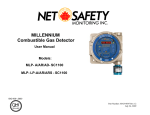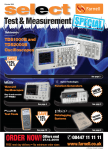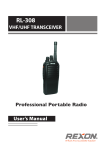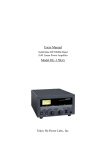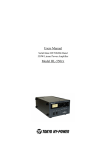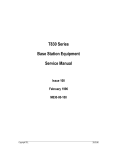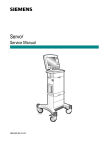Download HL1.1Kfx Users Manual
Transcript
Users Manual Solid-State HF Band 600W Linear Power Amplifier Model HL-1.1KFX 1. Introduction Thank you for purchasing the HL-1.1KFX. This compact and lightweight desktop HF linear power amplifier has a maximum input power of 1.35kW. Our solid-state broadband power amp technology makes it the smallest and lightest in the industry in its class. Typical output power is 600W PEP (SSB, CW) with the drive power of 65-90W. It is best suited for the DX-pedition use due to its light and compact design. 2. 2-1 Cautions The amplifier is cooled by forced airflow. Several inches of clearance on the top and the rear wall are necessary to allow for smooth air intake into the fan. Do not block the air vents on the top cover. 2-2 Keep the amplifier out of direct sunlight, in a cool dry environment. This unit is not corresponded to protection against dust, water, condensation, nor vibration. 2-3 Internal high voltages (AC, DC and RF), are present at all times, ON AIR or OFF. Internal access should be limited to avoid injury. 2-4 Turn off the AC main power immediately upon any unusual sounds, sights, or odors. Check the multimeter readings of Vd and Id, the fuses and all cable connections around the amplifier. Please notify the dealer or the factory of any problems. 2-5 For your safety, do not operate the amplifier without adequate grounding. A proper ground connection will result in peak performance and stability, in addition to reduced RF strays or noises. 2-6 To eliminate the RF interference to such home appliances as TV, FM radio, telephone sets, and etc., it is recommended that clamp-on ferrite cores be inserted at both ends of the remote control cable, ALC cable, coaxial jumper cable, and antenna cables, as needed. Also, a common mode AC line filter (near the AC outlet), and in-line low pass filters on the antenna coaxial cable (as necessary), are recommended. 1 2-7 The amplifier has fast acting sophisticated protection circuits. Please note, however, any such actions that cause the same fault to occur repeatedly, will lead to failure of the valuable final power FET transistors. 2-8 Before checking inside the amplifier, be sure to wait a few minutes for the high DC voltage to discharge (monitor Vd meter reading). The potentiometers for RF power detector, protection circuits, FET bias voltage circuit, etc., are precisely adjusted at the factory, and should not be altered. Doing so, would require readjustment with precision measuring instruments. 2-9 The DC power supply section consists of most efficient and sophisticated switching mode circuit. It accepts the wide AC line voltages ranging from AC 100V up to 260V. Since the line voltage is detected and selected automatically, you do not have to worry about the tap change of internal power transformer whichever country you will travel. Be sure to verify capacity of AC line fuse before you plug the AC power cord into the outlet. 2-10 Before starting the amplifier, be sure to connect a dummy load (50 ohms, 600W min.) or a well-adjusted antenna to the output terminal. Operating without any load will cause extreme stress to the RF power FET’s, although protection circuits should work under critical conditions. 2-11 Required drive power is slightly less than 100W to obtain the full 600W output. Do not attempt to operate with excessive drive from a high power transceiver. 2-12 Keep the aluminum heat sink and air openings free from dust and blockages. Periodic cleaning will prevent degraded cooling efficiency. 2-13 For long continuous operation in RTTY/FM modes, it is recommended that you reduce the RF drive levels by 20% to 30% lower output than CW/SSB modes. 2-14 To prevent damage to the precision electronic components, avoid extreme physical shock to the amplifier. If factory service is required, the amplifier should be shipped using the original box and packing materials. 2 3. 3-1 Features Our solid-state broadband design engineers worked to make the HL-1.1KFX, the lightest and most compact 600W out portable HF amplifier in the industry. This world-class compact 600W HF amplifier is the easiest to handle and operate anywhere in the world. 3-2 The amplifier’ s main PA section includes 4 high power MOS FET SD2933 / THP2933, resulting in 600W PEP (SSB/CW max.) on HF. The amplifier’ s broadband characteristics require no further tuning once the operating band is selected. 3-3 The amplifier allows operation in full break-in CW mode due to the use of the amplifier’ s high-speed antenna relays (made by Panasonic). 3-4 With the unique duct structure design and the powerful blower fan, the aluminum heat sink block for RF PA module (and other components), are effectively cooled. The fan’ s quiet operation allows for even the weakest DX signals to be heard. 3-5 The amp utilizes a sophisticated circuit to run the various high speed protection circuits such as overdrive, high antenna SWR, DC overvoltage, band miss-set etc. 3-6 This amplifier is compatible with wide AC line voltage ranging from AC 100V to 260V. Although AC line voltage is automatically selected, be sure to install proper fuse into AC line fuse holder. 3-7 For the safety of the operator, an Interlock system is employed. The AC power is shut down if the top cover is removed, and the automated safety interlock is activated. 3-8 An analog multimeter allows the operator to monitor Pf (Forward output power), Pr (Reflected power), Vd (Drain voltage of power FET), Id (Drain current) etc. 3 4. Specifications Frequency 1.8~29.7 MHz all amateur bands including WARC bands Mode SSB, CW (RTTY) RF Drive 65~90W typ. (100W max.) Output Power 600W PEP typ. (RTTY 400W max.) Drain Voltage 48V Drain Current 30A max. Input Impedance 50Ω (unbalanced) Output Impedance 50Ω (unbalanced) Final Transistor SD2933 / THP2933 x 4 Circuit Class AB parallel push-pull Cooling Method Forced Air Cooling Multi-meter Output Power Pf 1kW Reflected Power Pr 100W Drain Voltage Vd 60V Drain Current Id 50A Input/Output Connectors UHF SO-239 AC Power AC 200~260V, 50/60Hz 7.5A max. AC 100~130V, 50/60Hz 15A max. AC Consumption 1.4kVA max. when TX Dimension 232 x 145 x 392 mm, 9.1 x 5.7 x 15.4 inches (WxHxD) Weight Approx. 9.5kgs. or 22.5lbs. Accessories AC Power Cord x 1 Coax Jumper Cable (with PL259’ s) x 1 RCA Plug x 2 Spare Fuse 8A x 2 (for AC200V line) Spare Fuse 15A x 2 (for AC100V line) Spare Fuse 15A x 2 (for F202, F203 of PC1662V power amp board) Spare Fuse 1A x 1 (for PC1662V power amp board) (miniature fuse) Spare Fuse 2A x 1 (for PC1785V control board) (miniature fuse) Users Manual 4 5. 5-1 AC Line Voltage Although the amplifier is designed to work with both AC 115V (100-130V) and AC 230V (200-260V), for stability we recommend operation from AC 230V. 5-2 The correct AC plug (not included in the package) must be obtained locally due to the AC plug variations worldwide. 5-3 The AC line fuse has been factory preset for 115V use (or as requested by the customer at the time of order). If you wish to change to AC 230V, change the fuse to 8A. For your safety, before making this change, be sure to pull the AC plug from the AC outlet to avoid injury. NOTICE Please note the followings when you are using AC100V line (AC100V~120V). NEVER EXCEED OUTPUT POWER OF 500W, WHEN RUNNING THE AMP FROM AC100~120V LINE. Otherwise, over-current protection completely shuts down the drain voltage power supply for five minutes before it gets resettable. When this protection works, O.DRIVE lamp lights and HL-1.1KFX will enter the through state, the reset of the amp being disabled for five minutes. To restart the amp, turn the POWER switch OFF, and wait for 5 (five) minutes. Then turn the power ON. If the protection works too often, please take one or all of the following measures. ① Lower the drive power of the transceiver. ② Connect the ALC line. Adjust the ALC Output Adjustment Knob on the rear panel so that the drain current (ID) will never exceed 26.0A on any frequency. ③ Change to AC200~240V line. 5 6-A. Front Panel Description 10 13 12 11 14 TOKYO HY-POWER SOLID STATE LINEAR AMPLIFIER FAN ID METER BAND PROTECT POWER OPER ON AIR O.DRIVE PR O.VOLT FUSE O.HEAT MODEL OFF STBY 1 2 3 ①POWER HL-1.1 K FX 4 5 6 7 8 9 : Main power switch to turn AC power on and off. ②POWER (LED) : Green LED lights when power is turned on. ③OPER. : OPERATE/STAND-BY switch. At OPERATE, the amplifier is ready to go into ON AIR (TX) mode and at STBY, it is on STAND-BY mode. ④ON AIR (LED) : Green LED lights when the amplifier is in transmit (TX) mode. ⑤O.DRIVE (LED) : When overdrive or band miss-set is detected, LED lights to indicate the protection circuit has worked. ⑥PR (LED) : LED lights when reflected power from antenna exceeds 70W to indicate protection circuit has worked. ⑦O.VOLT (LED) : When the DC drain voltage of the FET (Vd) is too high, the LED lights to indicate the protection circuit has worked. ⑧FUSE (LED) : LED lights when the 15A glass fuse has blown from excessive Id. (Two fuses are on the PC1622V PA board.) ⑨O.HEAT (LED) : When the PA module temperature reaches 80 deg.C, the LED lights to indicate the protection circuit has worked. (It is necessary for the cooling fan to operate for several minutes to cool the PA module.) (Turn the main POWER switch to off, and then on again to reset the Protection Circuits.) ⑩BAND : Select the desired operating frequency band. ⑪METER : To change the multi-meter scales. Meter reads Pf, Pr, Vd, and Id. 6 ⑫ID (LED) : LED lights when the input drain current is over 20A. This does not mean that any damage occurred to the amplifier, but is useful for the user to notice any stress influencing the final FET caused by high drain current, load impedance trouble, etc. We recommend that you note the usual condition of the lighting. When any unusual symptoms are noticed, the user may lower the drive power from the transceiver, check the antenna SWR, etc. ⑬FAN (LED) : LED lights when fan is running at high speed. When the heatsink reaches 50℃ the cooling fan will switch to high-speed mode to cool the heatsink. ⑭MULTIMETER : Pf (Forward output power), Pr (Reflected power from antenna), Vd (FET drain voltage), and Id (FET drain current) are shown on the scale as selected by ⑪METER select switch. 7 6-B. Rear Panel Description FUSE ANT IN PUT AC ALC ADJ STBY ⑭AC POWER ALC GND : AC Mains Socket. Socket for the AC power cord. (Socket is EMI filtered.) ⑮STBY : RCA Jack. Connect the control cable from the ACC terminal (or SEND, TX GND etc.) of the transceiver. The center pin is to be shorted to ground though the relay circuit of the transceiver. The DC current necessary is 5V, 1mA only. ⑯ALC : RCA Jack for ALC Voltage Output. Negative DC voltage appears at the center pin, which is fed back to the ALC terminal of the transceiver. ALC is used to keep the amplifier output power at certain limits. Also it is useful when the transceiver output power is higher than 100W. (See page 12, 8.ALC Connection). Also consult your HF transceiver’s user manual. ⑰GND : Ground Terminal ⑱ALC ADJ : Potentiometer to adjust ALC voltage level. Minus 10V is available at maximum, when turned full counter-clockwise. Factory setting is 0 volts, with the pot turned full clockwise. ⑲FUSE : A pair of fuses for AC mains. 15A glass pre-installed fuse. (Change to 8A fuses if 230V line is used.) ⑳IN PUT (TX) : RF Input Connector. Connect the coax jumper cable from the transceiver. 21 ANT (OUTPUT) : RF Output Connector. Connect the coax cable to the antenna. ○ 8 Inner Layout of HL-1.1KFX Upper View ①RF Power Detector and Send-Receive Switching Relay ②Inter-lock Switch ③Sub- Power Source Unit ④LPF Board ⑤Main Power Source Unit ⑥Sub- Fan (for Main Power Source Unit) ⑦Control Board ⑧Power Amp Unit ⑨Frequency Detector Board ⑩Cooling Fan ⑪AC Fuse 9 7. Connection and Operation This section explains a one-antenna system connected to the transceiver and an external SWR/POWER meter. KFX REAR SIDE TRANSCEIVER ALC ACC (SEND,TX GND) SWR/POWER METER TX ANT ANTENNA ANT ANT INPUT AC STBY HL-1.1KFX 7-1 ALC REAR SIDE Connect AC cord and coax cables as illustrated above. Connect the cable from “SEND” to ACC or the remote terminals of transceiver, where it is marked “SEND” or “TX GND”. These terminal pins are shorted to the ground when the transceiver is in TX/ON AIR mode. If these connections are not made, the amplifier will not go into TX (amplification) mode. For a temporary check to the amp, ground the SEND center pin by inserting and RCA plug whose center pin has been soldered to the outer case of the plug with a small piece of wire. 7-2 At first, turn the ALC knob full clockwise to avoid ALC voltage to the transceiver. Application of ALC will be covered in the following Section 8. ALC CONNECTION. 7-3 Keeping the POWER (AC mains) switch off, check the SWR of your antenna by keying the transceiver to TX mode (CW or RTTY mode). Monitor the SWR with an external SWR/Power meter. If SWR is 1.5 or higher at band center, the antenna has to be adjusted for lower SWR. As an alternative, an antenna tuner may be inserted. 10 7-4 Turn the POWER switch on. Turn the BAND switch to a desired operating frequency band. Turn the STAND-BY switch to OPER (operate) position and the amplifier is ready to go. If you key the transceiver with the carrier level set relatively low (such as 20-30W), you will achieve an amplified output signal of few hundred watts. Monitor this output with the multimeter (in the Pf position) or with an external power meter. Increase drive level to roughly 50W and see if the antenna SWR stays constant. (As higher RF currents flow, some antennas may show a changed SWR value due to heated connector junctions and trap coils.) 7-5 You can now increase the drive level to nearly 80-90W to achieve maximum carrier output power of 600W (CW) from the amplifier. If you change to SSB mode, average voice power of a few hundred watts will be observed on the panel meter, Pf scale, while peak voice power reaching a little over 600W. For high duty cycle transmissions like RTTY mode, it is recommended that you reduce the drive power by some 30%. 7-6 With a high power transceiver in SSB mode, you can overdrive the amplifier resulting in a distorted output signal. This can occur if you speak too loud or if you set the microphone gain too high. Speak into the microphone properly to reduce the possibilities of splattering into the neighborhood. The ALC is effective in preventing the output signal from being distorted or to limit the carrier level to within rated output levels. It is strongly recommended to make ALC connection, especially when 200W out high power radio is used to drive. 7-7 Protection circuits may work during operation depending on the conditions. If the protection circuit has shut down the amplifier, check the antenna SWR, Vd, AC line voltage, or try to reduce the drive level. To reset, turn off the POWER switch once, then back on again. The power transformer has an overheat protection in the coil layer. If this temperature switch activates, the amplifier will put you in receive mode with the cooling fan operating until the transformer has cooled off. It may take ten to fifteen minutes to cool, depending upon room temperature. For more details on this protection circuit, see Section 9. PROTECTION CIRCUITS. 11 8. ALC Connection ALC voltage is available at the terminal marked ALC (RCA phono jack) on the right upper corner of the rear panel. Negative maximum DC voltage of ten volts (-10V) is produced at this terminal when the amplifier is fully driven. This voltage is adjustable with the ALC ADJ. knob located above the ALC jack. If the ALC voltage is properly fed back to the transceiver, we advise you to keep the maximum output power constant or hold the power at a certain level. Also ALC is useful in avoiding your SSB signal from being distorted when overdriven. You may not always need to connect ALC to the transceiver, if you set the mic gain properly and do not overdrive the amplifier. Depending upon the manufacturer of the transceiver, the suitable ALC voltage differs. ICOM may need 0~-4V, ad Yaesu may need 0~-5V range. Kenwood may need -6~-8V maximum. Check your transceiver manual. 8-1 Prepare an ALC control cable using RCA plug supplied in the package. Solder a single wire or (more preferably) a shielded single wire to the center pin of RCA plug and solder the shield braid to the outer side of the plug. Connect the control cable to the “ALC (or ETERNAL ALC)” jack of the transceiver. External ALC input is sometimes available at one of the pins of the “ACC” socket of the transceiver as well. 8-2 At first, turn ALC ADJ full clockwise. Drive the amplifier in CW/RTTY mode to full output power. Then turn the ALC ADJ counter-clockwise. Observe the SWR/Power meter at the output, (or Pf of the multimeter). Stop turning the ALC ADJ at the point the power starts to decrease. Or if you wish to further reduce the power, keep turning ALC ADJ until the desired level is achieved. If you further try to increase the drive power you will now see the output power become rather saturated, fro these adjustments. (Maximum ALC voltage produced is -10V when the amplifier output power is over 200W.) ALC ADJ AC MAX REAR PANEL ALC POT. STBY ALC To Transceiver 12 MIN 9. Protection Circuits There are five major protection functions in this amplifier. If the amplifier has shut down for some reason, before re-setting, correct the possible cause of the shut down. Turn off the POWER once and back on to reset. 9-1 O. DRIVE (Over Drive / Band Miss-set) When the drive power exceeds the 100W level, the amplifier will shut down to STAND-BY mode (or receive) in order to protect the input side of the power FET’s. This protection might also activate if the band is set wrong. This usually occurs, when the amplifier band setting is lower than that of the transceiver. 9-2 O. HEAT (Over Heat) When the temperature of the aluminum heat sink in the power amplifier reaches 80 degrees C, the amplifier defaults to RECEIVE mode to protect the power FET’s. 9-3 O. VOLT (Over Voltage) If there is a sudden AC line voltage spike, the FET drain voltage may rise above acceptable levels, and O. VOLT protection may trip. 9-4 FUSE (Fuse Blown) If either of the glass fuses (15A) on PC1662V fails, O. VOLT protection activates. Under normal usage of the amplifier, this failure should rarely (if ever) occur. If it occurs, there is a possibility that the power FET’s have failed together. If the amplifier cannot be reset, consult with the dealer or the service center. 9-5 PR (Reflected Power Protection) If reflected power because of the antenna reaches approximately 80W, the PR protection may trip. If it does, one solution is to reduce the drive power from the transceiver. Or you may need to check that your antenna match (SWR) is still OK. If the match cannot be corrected and the antenna system isn’t faulty, use an antenna tuner. As noted above, the amplifier is equipped with several kinds of fast acting protection circuits using the latest in analog technology. However, if the amplifier is operated in such a manner that multiple protections work repeatedly over a long period of time, the amplifier can be seriously damaged. 13 10. Explanation of Major Circuits Five major circuit blocks are explained in their basic form and using signal flows. 10-1 Main DC Power Supply 10-2 Power Amp/ L.P.F. 10-3 RF Power Detector/ TX-RX Switching 10-4 Control Board 10-1 Main DC Power Supply The main DC power supply feeds the 50V DC power to the final PA stage. It is a state of art, switching power supply with high efficiency. A part of 50V line is converted to 24V using a DC-DC converter and is supplied to the cooling fan. 10-2 Power Amp (PA PC1662V) / L.P.F. (PC1399B) The RF PA is the heart of this amplifier and is composed of four SD2933 MOS FET’s made by ST Micro, a French-Italian joint venture firm. The amplifier is a parallel push-pull type of class AB amplifier. The gate bias supply circuit is regulated for the best stability and is thermally compensated. The PA has a 6dB attenuator on the input for gain reduction and to enhance the stability of the wide band power PA. The heat sink has two different thermal sensors to detect temperatures of 40 deg. C, and 80 deg. C, respectively. At 40 deg. C, the cooling fan shifts into high-speed mode. At 80 deg. C, the amplifier will lock the amplifier into RECEIVE mode to protect the power FET’s. In the L.P.F. (output low pass filter) circuit, there are eight different band filters that are selected either by the auto band decoder or by the manual band switch. Each L.P.F. is used to reject harmonics so that the amplifier meets international telecommunication equipment standards. 10-3 RF Power Detector / TX-RX Switch (PC1398B) As illustrated in the block diagram, there are two RF power detectors on this board. One detects the drive signal level from the radio and the other monitors the outgoing power and the reflected power from the load (antenna). The TX-RX switch (Send-Receive switching) will switch the flow of drive power/output power and the incoming signal from the antenna with two high-speed relays mounted at the input and output sides of the PA. 14 10-4 Control Board (PC1698) This is the heart of the control signal processing for the HL-1.1KFX. It judges the operating condition of the amplifier, as well as issuing the commands to the peripheral circuits. Various analog signals are processed such as RF drive from the transceiver, RF power signals at various points, DC power supply information, etc. There are ope-amps, various three terminal voltage regulators, GAL logic device etc. Warning signals are processed by the logic IC for Over Heat, Over Voltage, Pr, Band Miss-set etc. Ope-amps produce the necessary DC signals to drive the Pf, Pr meters. Also there is a control circuit that issues the drive shut down command in case of the over drive, band miss-set and high antenna SWR conditions. 15 11. Trouble Shooting Failure Possible Cause Solution AC mains not ① AC fuses blown ① Replace with new ones. operating ② AC cord not plugged in ② Plug in securely. ③ Interlock switch lifting ③ Screw bolts tightly on the top cover. ④ Wrong tap used on power transformer primary Can’t enter Transmit mode ④ Correct primary wiring. ① Remote control cable ① Check the cable and connect properly. not connected ② Protection circuits on ② Check the drive power, antenna SWR, antenna selector A/B. Reset with AC POWER switch. O.Drive lights PR lights ① RF overdrive ① Decrease drive. ② Band miss-set ② Match the BAND correctly. ① Reflected power high, ① Check/adjust antenna Antenna SWR high (Or decrease drive.). ② Poor connection to coax cables O. Volt lights ② Check the coax cable connectors. ① Drain voltage of power ① Check AC line stability. amp extremely high FUSE lights ② Fuse blown ② Replace F202 and F203 (20A) on the PA board (PC1662V). ③ Antenna SWR high ③ Adjust the antenna. ④ Short circuit ④ Contact the distributor, or service center. O.Heat lights Cool off until LED turns off. Check for air ① Internal Temperature above 80 deg.C intake blockages. Also check air vent on top cover. TVI, FMI ① Overdrive ① Decrease the drive. Check ALC setting. ② RF leakage from coax ② Insert common mode filters on cable, grounding wire, antenna cable or AC line. Add AC power cord etc. clamp-on ferrite cores (TDK, Amidon, Palomar) on various cables. 16 12. Parts Layout 12-1 Top View (Detailed) 12-2 Top View & Side View 12-3 PA (PC1662V) 12-4 Power Detector (PC1398B) 12-5 Control Board (PC1785) Front View 12-6 Control Board (PC1785) Copper Side 12-7 L.P.F. (PC1399B) 12-8 Frequency Detector Unit (PCS1733) 12-9 Sub DC Unit (PC1784) 13. Schematic Diagrams 13-1 PC1662V PA (Power Amplifier) 13-2 PC1398B RF Power Detector 13-3 PC1399B L.P.F. (Low Pass Filter) 13-4 PCS1733 Frequency Detector Unit 13-5 PC1785 Control Board 13-6 Overall Block Diagram 17 HL1.1KFX DEVELOPMENT CHART MAIN SW POWER SUPPLY(ADF1000F48) METER SUB SW POWER SUPPLY(ADF1015) LPF UNIT(PC1398B) SUB FAN FUSE(F1、F2) DET UNIT(PC1398B) MAIN FAN CONT UNIT(PC1785) PA UNIT(PC1662V) F DET UNIT(PC1733) TOP VIEW LEFT SIDE VIEW RIGHT SIDE VIEW PC1662V RF OUT J201 RF IN F201 MINI FUSE 1A VR205 BIAS REF HI LO VR204 VR201 VR203 HI LO FET BIAS ADJx4 (VR201∼VR204) VR202 PC1398B DET UNIT J504 RF IN J505 RF OUT TC503 PR ADJ TC501 TX ADJ TC502 PF ADJ J501 RL502 RL501 J502 HL1.1KFX CONTROL BOARD(FRONT VIEW), PC1785 VR101 PF SCALE ADJ VR102 PR SCALE ADJ VR103 ID SCALE ADJ LO HI VR101 VR102 VR1013 FUSE(F101.F102 2A) IC108 D704 VR106 TP VR105 TP VR107 VD SCALE ADJ VR105 BAND MISS SET ADJ VR106 O.DRIVE ADJ J303 PC1399B LPF J304 RL307/L302 L301/RL301 RL311/L310 L309/RL305 RL309/L306 L305/RL303 RL310/L308 L307/RL304 RL312/L312 L311/RL306 RL308/L304 L303/RL302 PC1399B LPF(COPPER SIDE) PCS1733(COPPER SIDE) PCS1733 TC1 J3 J4 J1 J2 IC1 PC1784 F301 J301 PC1784(COPPER SIDE) J302 J302 -15V COM +15V FG AC IN AC IN J301 FB 1 OH1 IC201 78L08 R234 120/1W RT201 TH R238 1k C-EX 0.01 2 タンタル 3 C226 + 10u G + T/R C225 10u G FB203 EXCELSA35 3 5 6 7 B7B-EH R235 2.2k C242 0.01 R237 5k C-EX 0.01 パターンカット I 2 4 +15V Q205 2SC1959 TL431 1 VR205 10k LED201 R236 4R7 G タンタル O R237A 2K OH2 S202 80degree J206 C-EX 0.01 1 C-EX Bttto side VR204 2k D204 1S2076A R216 47 1/2W R227A C207 2 0.1u VR203 2k J201 R205 100 10W TMP-J01x-V6 D203 1S2076A R215 Q203 SD2933 C208 R224 4.7k R225 1R0 R210 39 10W J204 J205 T202 D12A 5 R223 T201 D12A 3:1 TMP-J01x-V6 R223A R206 100 10W R201 50 10W R207 150 10W R212 150/5w R208 150 10W C205 150p CH2H R222 R203 50 10W 12/5w *4 1 2 R222A R202 50 10W 3 0.1u VR202 2k D202 1S2076A J202 82P CH2H 220p 270p chip chip 2 3 4 C233 0.1u chip R220A 1R0 R214 47 1/2W C227 C228 1 C229 C234 0.1u chip C211 C211A 0.1u *2 chip C202 C237 0.01u T203 D12A 1:3 6 4 C205A 250p chip ISO202 TLP521 G R232 10k C235 0.1u chip LED310 F201 LM10 1A 0.1 C238 R231 4.7K1W R225A 1R0 RL201 R311 51 1/2W VDD2 C212 C212A 0.1u *2 chip 47 1/2W C-EX 0.01 FB202A C224 0.1×2 chip C222 0.1×2 chip 0.1u R204 100 10W G F203 15A R226 4.7k R227 1R0 0.1u 2.2k R310 S201 50degree L202 FB202 1R0 Q204 SD2933 C209 2 OH1 C215 0.01u C213 C213A 0.1u *2 chip 1 G 3 B4B-EH R228 220/5w B2B-EH J210 2 4 4.5V 1 OH2 Q202 SD2933 L201 C204 R220 1R0 0.1u VR201 2k C201 T203 D201 1S2076A R221 4.7k FB201 F202 15A R218A 1R0 R213 47 1/2W Q201 SD2933 タンタル 3.3μ/25V C203 C219,219A,221,221A 0.1μx4 chip 0.1u FB201A C210 C210A 0.1u *2 chip R218 1R0 C217 0.1×2 chip C218 0.1×2 chip R219 4.7k R229 4.7K1W パターンカット 3 R217 220/5w 1 T203 PRI D12A 1T VDD1 R230 10k G C239 0.01u ISO201 TLP521 C214 0.01u 2nd 3T 銅板にてショート2カ所有り 承認 検図 検図 担当 第三 角法 溝呂木 溝呂木 処理 TOKYO HY-POWER L1373JH 個数 PC1662V HL1.1KFX アンプ回路 図番 H18.4.6 材質 品番 設計 H18.4.6 承認 型名 製図 単位:mm 検図 尺度 4 変更事項 名称 記号 2 C240 0.1 1373D01A J502 J501 AMP T501 J504 C510 470u 120P J505 C503 15p 6P D501 T502 22Ω/0.5W R501 TC502 6P RFC502 470u C502 1SS97 C504 C506 150P 0.01 120P C513 15p TC503 D502 D503 1SS97 1SS97 C505 150P ANT R502 6P RFC503 470u C511 C512 C509 120P 150P + C513 (裏付) 3.3μ/16Vタンタル R503 J503 22Ω/0.5W 22Ω/0.5W C501 0.01 RL502 G2R-1 C508 RL502 15p TC501 RFC501 RL501 RL501 G2R-1 IN FIL 1 COX 2 COX G 3 T+15V 4 T/R 5 PF 6 G 7 PR 指定なきコンデンサーは 0.01uF50V 指定なきダイオードは1S2076A 旧型名L1303HVJ 検図 検図 担当 溝呂木 材質 処理 TOKYO HY-POWER L1373JH PC-1398B 検出基板 個数 HL1.1KFX 図番 溝呂木 第三 角法 承認 品番 設計 H18.3.29 検図 型名 製図 H18.3.29 単位:mm 尺度 承認 変更事項 名称 記号 L1373D04 J301 J302 C302-1 470p 50p * * * (3.5/3.8MHz) C320 C321 400p 100p * * L304 12T T106-2 1 2 RL308 3 4 5 39p C323 C324 C325 C326 C326-1 * * * * C330 30p * 250p 15p 6 C331 * 39p 400p 400p 100p 200p 33p * 470p 400p 200p 200p * * C322 * * * C313 L303 13T T106-2 RL302 J303 C316 C315 C316 C317 C307 C308 C309 C310 C312 * * * * * C305 150p 470p 470p 470p 470p 250p RL307 C302 470p RL308 C301 RF OUT RL307 RL309 (1.9MHz) 2130pF RL310 RL301 L302 16T T106-2 RL311 L301 20T T130-2 RL312 RF IN 7 +15V B1 B2 B3 B4 B5 B6 200p * C327-39p * C328-39p C329-15p L305 10T T106-6 39p C335 RL304 C337 39p C341 C342 400p 200p * C339 250p 27p * * L308 7T T106-6 L307 T106-6 7T (10/14MHz) * RL310 J304 C343 5p C346 C347 C348 10p C350 150p C345 150p 150p 33p C349 150p * * RL305 L309 * 1 * 9T L310 2 RL311 8T RL301 250p C336 RL302 22p * RL303 C333 * RL304 C332 RL305 (7MHz) RL309 L306 T106-6 10T RL306 RL303 3 4 5 6 (18/21MHz) C351 * 100p C352 6p 5p C355 2p 200p 20p C356 * 15p C357 C358 C359 82p 12p * C353/354 RL306 L311 (24/28MHz) RL312 L312 7T C360 C361 5p C363 C364 39p 39p C362 150p 8p * * 7 +15V B1 B2 B3 B4 B5 B6 * C365 7T 2p C367 C368 39p 33p * チップコン表示 d2:400p A2:100p a2:250p Y1:82p E2:150p Q1:39p H2:200p N1:33p C366 12p *はチップ 検図 検図 担当 溝呂木 材質 処理 TOKYO HY-POWER L1373JH PC-1399B LPF基板 個数 HL1.1KFX 図番 溝呂木 第三 角法 承認 品番 設計 H18.3.29 検図 型名 製図 H18.3.29 単位:mm 尺度 承認 変更事項 名称 記号 L1373D02A 1 2 3 5 4 6 7 A A J1 R1 10k 1W 7mV B J2 70Vrms RF in RF out C1 4P D3 1SS286 C2 100p D2 1S2076 D1 1S2076 R4 1k R5 C3 0.01 L1 1mH 10k B IC3 C6 0.01 R3 50 2 FMin 1 Vcc 20MHz PSC 7 R9 X1 3 SWin S/F 6 4 GND OUT 5 220k C5 Bias 8 C8 R8 2.2k TC1 220 C10 20p 2 GP5 3 GP4 J3 R12 47 1 2 C13 10uF DC15V G C14 R13 100 Vss 8 4 GP3 GP0 7 0.1uF RL1 GP1 6 D4 GP2 5 1S2076 C J4 3 2 1 Stby out Stby in NC C11 R15 4.7K Q1 0.01 C12 10uF IC2 0.01 R7 40mV 0.01 1 Vcc C7 PIC12F683 IC1 C4 C C9 0.01 0.01 TD7101F R2 470 78L05 33p R11 10k 56p Q2 2SC1815 J5 2SC1815 1 2 予備 D D 注意:J4の端子順番 PCS1733 E 2007.6.20 1 2 3 2007.6.20 L1373JH 4 5 6 F DET E 1373D08 7 PC1785 HL1.1KFX CONTROL UNIT EXCELSA35 FB101 51Ω1/2W B5 6 B6 7 C106 C105 C104 C103 C102 C107 0.001 0.001 0.001 0.001 3 C141 10u (10/14) (18/21) + C142 0.01 + 5 2 100K VR105 (BAND MISS ADJ) RA103 10k + NC NC NC (24/28) 2 R141 51K C155 3.3μ タンタル R143 1.2K C151 0.01 4 5 7 1 6 6 7 IC102 LM339 8 9 J102 +15V 10 1 B1 2 B2 3 B3 4 B4 5 B5 6 B6 9 C109 0.1 1 2 3 G 4 +15V 5 T/R 6 G 7 R101 100 R514 C114 0.001 C112 0.001 FB102 C115 0.001μ VR101 100k (PF ADJ) C113 0.001 C126 10u 12 R127 10 C128 10μ D113 1S2076A VR102 100k + + R128 10k R107 3K R106 1k + C129 0.01 PR 7 OUT IN OUT IN OUT IN OUT GND _OE 16 R137 15 R138 LED104(O.D/B.M.S) 3 LED105 (PR) LED106 (O.V) LED107 (F.B) LED108 (O.H) 14 13 12 11 注意:PA基板J210の①② に極性が逆接続 J114 to PC1662V RL201 R144 1K 1 R129 4.7K 2 RL101 D708 SR140 D111-2 HZ24-3-E C147 0.01 R124 100K R142 2k R706 47Ω1/2W C152 R111 0.01μ 100K IC101 10 9 8 ADJ) LF347 R513 1K R109 1.2K 1 2 1K R114 6.2K 3 R123 150K R112 1K 0.01μ C608 C607 0.001μ VR103 50K J110 to LED102 D114 HZ3C2 1 LED102 (ID ADJ) 2 R120 1K +15V ON D511 UZP30B AIR LED103 RA102 47 IC101 LF347 J109 (ALC VR) R115 1 22K 2 4 D107 1S2076A 5 7 6 + R702 2.2K 1/8W D112 1S2076A R118 R145 10K 1K J108-1/2 STBY 6 IN R136 STBY 5 OUT 17 470*5 R121 1K STBY STBY 4 IN R135 +15V -15V R512 10K 3 3 G OUT R134 18 +5V -15V PF IN 19 14 11 R104 47Ω5W T/R OUT C146 10u J108-2/2 OPR OUT IN C127 0.01 R113 39K 2 M- C148 + 1u/50V タンタル C609 1u/50V タンタル R105 150K 1 M+ 4 4 13 R108 COX 3 +5V IC101 LF347 (PR J105 LANP+ Q101 2SC1959 Q102 2SC1815 13 IC102 LM339 33K R102 100 C111 0.001 R126 3.3K 11 10 + R103 100 COX G IN D110 1S2076A + R700 10k VR106 20K (OD ADJ) (VD ADJ) 50KΩVR VR107 M LANP- C145 0.01 C610 3.3μ タンタル RA104 10k SW102 (METER) M 2 D111-1 HZ24-3-E IC102 LM339 VD ID J103 FB C144 10μ VCC 8 PR C110 0.001 OH2 CLK 14 PF 7 OH1 + IC103 GAL16V8 1 3 R140 10k SW101 (BAND) C143 10μ RA105 10k IC102 12 LM339 D106 5 + 4 RA101 33Ω 1 +5V R131 220k R701 10k (7) D105 4 B4 C150 0.01 C154 10u C140 0.01 D109 1S2076A (3.5) D104 B3 C139 10u + (1.9) D103 3 D102 2 B2 D101 1 B1 0.001 J101 0.001 0.001 C101 C108 0.1 +15V J107 R130 +15V D108 1S2076A 2 1 SW103 R117 150K 22K R116 C606 220μ25V J104 1 FAN 2 FAN RIN 3 T/R IN 4 G 5 ALC 6 G 7 FAN 8 FAN RIN to Fan LED L or H C1300.001μ J112 to PC1733 J3 D510 IZ24 C121 C119 C117 0.001μ 0.001μ 0.001μ C120 C118 0.001μ 0.001μ J106 VD ID 2 ID-G 3 +15V 4 G 5 AC15V 6 AC15V 7 F101 LM20 C131 C132 470u 0.01μ J111 SUB SW FAN C702 220u/16V 2 + + + R707 15Ω2W C137 10u 1 G C138 10u/16V タンタル + 2 R703 4.7K 7 forJ104⑦⑧ D703 Fan L or H R705 200K 8 承認 変更事項 検図 検図 製図 H20.1.24 担当 設計 H20.1.24 材質 処理 TOKYO HY-POWER L1390HJ 個数 PC1785 HL1.1KFX コントロール基板 図番 溝呂木 承認 品番 溝呂木 第三 角法 検図 型名 PC***** 単位:mm 名称 記号 R704 470K 尺度 D702 RD18 変更:D708の追加(2008.3.28) +5V 2 5V O G 1 for J110 LED102 ID LED LtoH - + J113 to ADF1000F48 STBY C116 0.001μ IC108 7805A I G +24V 1K 1W -15V + + C125 10u IC104 7824 +15V 2 R511 POWER C134 C135 470u 10u/35V タンタル D704 IN4002 - + FB103 EXCELSA35 O G C605 C124 47u50V 10u C123 0.01μ 1 I R133 180Ω5W LED101 24V R132 180Ω5W 1K +15V + F102 LM20 C122 0.01μ + R119 1 1390D01A DET UNIT J504 INPUT ( RF IN ) PA ANT ( RF OUT ) JP3 2.5D2V JP1 J503 1 COX 2 COX G 3 OPR 4 T/R 5 PF 6 G 7 PR EHR-7 1 2 3 4 5 6 7 J501 RF IN RF OUT J502 JP5 2.5D2V EHR-7 RF OUT RF IN J1 J2 JP201 J203 FB OH1 OH2 G +15V T/R G 2.5D2V STBY IN STBY OUT JP29 PC1733 F-2 JP27 S-3 DC IN J3 G F DET UNIT J206 OH2 G OH1 G J210 JP6 VDD G 1 2 1 2 3 +5V STBY ON JP21 J301 AC NC AC NC FG SUB AC J303 EHR-7 +15V 1 B1 2 B2 3 B3 4 B4 5 B5 6 B6 7 JP10 JP11 EHR-7 1 2 3 4 5 6 7 1 2 3 4 5 6 7 FB48 FB47 FB42 FB25/26 FB44 FB43 0V FB27/28 JP22 FB23/24 FB22 FB21 FB14 FB13 FB12 1 2 3 4 5 6 7 JP20 PC1784 EHR-3 J302 +15V 1 -15V 2 COM 3 EHR-7 PC1785 CONT UNIT +15V +15V 1 B1 B1 2 B2 B2 3 J101 B3 J102 B3 4 B4 B4 5 B5 6 B5 B6 B6 7 FB OH1 OH2 J103 G +15V T/R G 1 COX 2 COX G 3 OPR 4 T/R J105 5 PF 6 G 7 PR FB41 YAW1015 (AC85∼AC264V) EHR-4 1 F-3 2 3.2A 3 4 J304 +15V B1 B2 B3 B4 B5 B6 JP8-1BFB38 JP8-1A FB37 RS FG FB49 JP23 RF OUT FB31 FB29/30 AC85∼AC264V FB50 J302 RF IN FB46 FB45 +DC48V JP24 EHR-7 1 2 3 4 5 6 7 シールド JP8-2A FB40 JP8-2B FB39 シールド JP25 PC1399B UNIT J301 シールド線 FB34 FB33 FB32 1 2 EHR-2 EHR-4 JP9 1 S202 2 3 S201 4 ADF1000F48 (AC85∼AC264V) JP30 POW SW S-1 2.5D2V RF OUT EHR-3 NC J4 JP26 JP4 J202 J201 RF IN JP7 1 2 EHR-2 FB36 FB35 AC85∼AC264V AC100V-15A AC200V-8A F-1 PC1662V UNIT FB50 JP28 2.5D2V LPF PC1398 J505 JP2 FB11 FB10 FB9 FB19/20 FB17/18 FB15/16 to PC1662V RL201 VD ID ID・G +15V G +15V -15V J106 2 1 J114 1 +5V 2 G J113 LANP JP12 EHR-4 C2 R3 LANP+ 1 J107 LANP- 2 A M1 M+ 3 M- 4 EHR-3 1 1 1 2 JP13 RV16YN 1K J109 2 2 (ALC ADJ) 3 3 3 EHR-4 1 1 2 2 STBYスイッチ JP14 J108 3 3 S-2 4 4 FAN 1 FAN RTN 2 T/R 3 G 4 J104 ALC 5 G 6 FAN 7 FAN RTN 8 EHR-7 to ADF1000F48 STBY JP19 D702 RD18 D102 BL又はBG LED ID LED LtoH FB7 to PC1733 J3 470K R704 JP18 D703 BL又はBG LED FAN LED Lor H 1 +15V J112 2 G FAN DC24V JP15 FB1 FB2 1 2 FB3 FB4 T/R J-3 RCA-J JP16 ALC J-4 RCA-J J111 + 1 - 2 FB8 4.7K R703 C1 0.01μ FB5 ADF1000F48 FAN DC15V FB6 1 2 J110 to LED102 JP17 200K R705 PC*** Overall Wiring Schematic 承認 変更事項 検図 検図 製図 担当 設計 承認 材質 個数 総合結線図 HL1.1KFX 処理 L1390HJ 図番 TOKYO HY-POWER 品番 溝呂木 溝呂木 第三 角法 検図 型名 H20.3.25 H20.3.25 単位:mm 名称 記号 尺度 注意:コント基板のJ114とPA基板のJ210間で1と2の極性が逆に結線 コント基板J104の①②からメインFANの①②間で極性が逆に結線 L1390D02



































